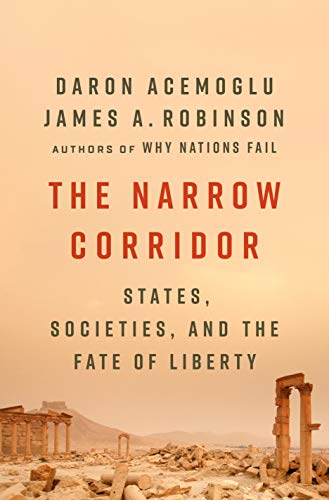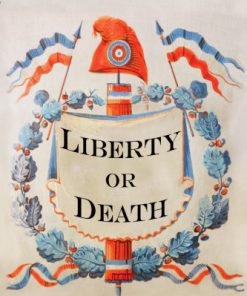The Narrow Corridor States Societies and the Fate of Liberty 1st edition by Daron Acemoglu,James Robinson 9780735224384 0735224382
$50.00 Original price was: $50.00.$25.00Current price is: $25.00.
The Narrow Corridor States Societies and the Fate of Liberty 1st edition by Daron Acemoglu,James Robinson- Ebook PDF Instant Download/Delivery:9780735224384,0735224382
Full download The Narrow Corridor States Societies and the Fate of Liberty 1st edition after payment
Product details:
ISBN 10:0735224382
ISBN 13: 9780735224384
Author:Daron Acemoglu,James Robinson
From the winners of the 2024 Nobel Prize for Economics and the authors of the international bestseller Why Nations Fail “Why is it so difficult to develop and sustain liberal democracy? The best recent work on this subject comes from a remarkable pair of scholars, Daron Acemoglu and James A. Robinson. In their latest book, The Narrow Corridor, they have answered this question with great insight.” —Fareed Zakaria, The Washington Post In Why Nations Fail, Daron Acemoglu and James A. Robinson argued that countries rise and fall based not on culture, geography, or chance, but on the power of their institutions. In their new book, they build a new theory about liberty and how to achieve it, drawing a wealth of evidence from both current affairs and disparate threads of world history. Liberty is hardly the “natural” order of things. In most places and at most times, the strong have dominated the weak and human freedom has been quashed by force or by customs and norms. Either states have been too weak to protect individuals from these threats, or states have been too strong for people to protect themselves from despotism. Liberty emerges only when a delicate and precarious balance is struck between state and society. There is a Western myth that political liberty is a durable construct, arrived at by a process of “enlightenment.” This static view is a fantasy, the authors argue. In reality, the corridor to liberty is narrow and stays open only via a fundamental and incessant struggle between state and society: The authors look to the American Civil Rights Movement, Europe’s early and recent history, the Zapotec civilization circa 500 BCE, and Lagos’s efforts to uproot corruption and institute government accountability to illustrate what it takes to get and stay in the corridor. But they also examine Chinese imperial history, colonialism in the Pacific, India’s caste system, Saudi Arabia’s suffocating cage of norms, and the “Paper Leviathan” of many Latin American and African nations to show how countries can drift away from it, and explain the feedback loops that make liberty harder to achieve. Today we are in the midst of a time of wrenching destabilization. We need liberty more than ever, and yet the corridor to liberty is becoming narrower and more treacherous. The danger on the horizon is not “just” the loss of our political freedom, however grim that is in itself; it is also the disintegration of the prosperity and safety that critically depend on liberty. The opposite of the corridor of liberty is the road to ruin.
The Narrow Corridor States Societies and the Fate of Liberty 1st Table of contents:
Chapter 1: How Does History End?
A Coming Anarchy?
The Article 15 State
A Journey Through Dominance
Warre and the Leviathan
Shock and Awe
Reeducation Through Labor
The Janus-Faced Leviathan
The Cage of Norms
Beyond Hobbes
Shackling the Texans
The Shackled Leviathan
Diversity, Not the End of History
Brief Outline of the Rest of the Book
Chapter 2: The Red Queen
The Six Labors of Theseus
Solon’s Shackles
The Red Queen Effect
How to Ostracize if You Must
The Missing Rights
Chiefs? What Chiefs?
A Slippery Slope
Staying Illegible
The Narrow Corridor
The Proof of the Pudding
Shackling the Leviathan: Trust and Verify
Chapter 3: Will to Power
The Rise of a Prophet
What’s Your Edge?
The Horns of the Buffalo
The Wrong Doer Who Knows No Law
The Red-Mouthed Gun
Breaking Taboos
A Time of Troubles
Why You Cannot Shackle the Will to Power
Chapter 4: Economics Outside the Corridor
The Ghost in the Granary
No Place for Industry
The Caged Economy
Ibn Khaldun and the Cycle of Despotism
Ibn Khaldun Discovers the Laffer Curve
Janus-Faced Despotic Growth
The Law of the Splintered Paddle
A Shark Going Inland
The Bird That Devours Others
The Economics of the Rose Revolution
Caged and Despotic Economics
Chapter 5: Allegory of Good Government
The Frescoes of Piazza Del Campo
The Effects of Good Government
How Saint Francis Got His Name
The First Cat in the Canary Islands
The Economy in the Corridor
The Effects of Bad Government
How Tortillas Were Invented
Chapter 6: The European Scissors
Europe Moves into the Corridor
The Assembly Politics of the Long-Haired Kings
The Other Blade
Bringing the Two Blades Together
Disunited Kingdom
1066 and All That
The Red Queen Effect in Action: The Magna Carta
The Grumbling Hive
A Profusion of Parliaments
From Thing to Althing: Europe Outside the Corridor
The Dollar of the Middle Ages: The Byzantine Leviathan
Moving on in the Corridor
The Next Cage to Be Broken
The Origins of the Industrial Revolution
Why in Europe?
Chapter 7: Mandate of Heaven
Capsizing the Boat
All-Under-Heaven
The Rise and Fall, and Rise Again, of the Well-Field System
Cutting the Queue
Despotism on the Cheap
A Dependent Society
A Reversal of Chinese Fortune
The Mandate of Marx
Growth Under Moral Leadership
Liberty with Chinese Characteristics
Chapter 8: Broken Red Queen
A Hate Story
India in the Cage of Norms
The Broken People
Those Who Dominate
The Caged Economy of Caste
Ancient Republics
Land of the Tamils
From Gana-Sangha to Lok Sabha
No Honor Among Varnas
The Broken Red Queen
Chapter 9: Devil in the Details
European Diversity
War Made the State, and the State Made War
The Sort of State That War Made
Freedom on the Heights
Differences That Matter
In the Lenin Shipyard
The Un-Taming of the Russian Bear
From Despotism to Disintegration
Because We Have To
Grounds for Divergence
Repression on the Finca
How History Matters
Chapter 10: What’s the Matter with Ferguson?
A Killing at Noon
The Collateral Damage of American Exceptionalism
What Bill of Rights?
American Slavery, American Freedom
The Circuitous Path of American State Building
We Shall Overcome
Life in the American Corridor
Who Gets Their Kicks on Route 66?
Why Can’t We Collect All the Signals All the Time?
The Paradoxical American Leviathan
Chapter 11: The Paper Leviathan
Patients of the State
Gnocchi in the Iron Cage
Failing the Duck Test
No Place for Roads
The Orangutan in a Tuxedo
Plowing the Sea
Mississippi in Africa
The Postcolonial World
The Consequences of Paper Leviathans
Chapter 12: Wahhab’s Children
The Tactician’s Dream
Domesticating the Ulama
Intensifying the Cage of Norms
The Untouchables of Saudi Arabia
Nebuchadnezzar Rides Again
The Seeds of 9/11
Chapter 13: Red Queen Out of Control
A Revolution of Destruction
A Rainbow Coalition of the Discontented
The Zero-Sum Red Queen
Despotism from Below
How the Red Queen Gets Out of Control
How Much Land Does an Inquilino Need?
For Whom the Bells Toll
The Allure of Autocrats
Who Likes Checks and Balances?
Back into the Corridor?
Danger on the Horizon
Chapter 14: Into the Corridor
Black Man’s Burden
The Rainbow Coalition
Doorways into the Corridor
Building on the Iron Cage
Black Turk, White Turk
A Viagra Spring
Taking the Orangutan Out of the Tuxedo
The Shape of the Corridor
A Different World?
The Corridor Globalization Makes
We Are All Hobbesians Now
Chapter 15: Living with the Leviathan
Hayek’s Mistake
The Cow Trade
The Leviathan vs. The Market
Unshared Prosperity
Wall Street Unhinged
Supersized Firms
Avoiding the Zero-Sum Red Queen
Leviathan’s War on Terror
Rights in Action: The Niemöller Principle
Photographs
Acknowledgments
Bibliographic Essay
Sources for Maps
People also search for The Narrow Corridor States Societies and the Fate of Liberty 1st:
the narrow corridor states societies and the fate of liberty
corridor theory
the narrow corridor book
the narrow corridor book review
c&s narrow gauge
Tags:
Daron Acemoglu,James Robinson,States,Societies,Liberty
You may also like…
Cookbooks
Business & Economics
Science (General) - Research & Development
Politics & Philosophy
Politics & Philosophy - Social Sciences
Politics & Philosophy
The Chinese Philosophy of Fate 1st Edition by Wei Yixia ISBN 9811043698 978-9811043697
History - Ancient History













